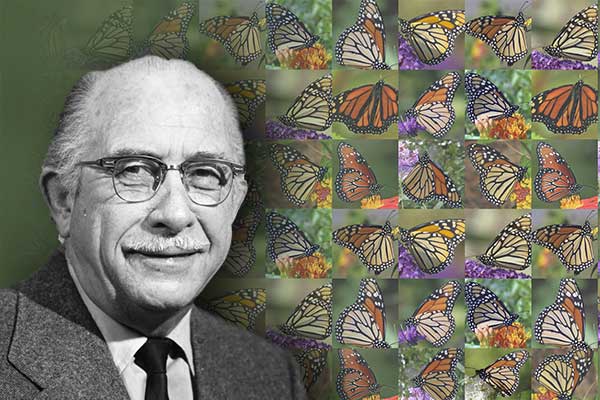
Flight of the Butterflies
Published: April 16, 2013
High atop a mountain in the Sierra Madra range of Mexico, Fred Urquhart first witnessed proof of his life’s work.
“I gazed in amazement at the sight. Butterflies – millions upon millions of monarch butterflies!” wrote Urquhart in a 1976 National Geographic story. “Breathless from the altitude, my legs trembling from the climb, I muttered aloud, “Unbelievable! What a glorious, incredible sight!”
That moment of discovery is immortalized in the award-winning IMAX movie Flight of the Butterflies, which opens at the Ontario Science Centre this week. The movie delicately weaves two stories into one: Urquhart’s perseverance and dedication to science mirrors the endurance of the half-billion monarchs on their epic 3,000-mile journey every year, the longest insect migration in the world.
Urquhart’s curiosity for insects blossomed as a young boy growing up in Toronto and led him to the University of Toronto in 1931 to study biology. By 1937, his curiosity became an obsession to identify the migratory route of the monarch butterfly.
Urquhart and his wife Norah – who also became his research partner – spent nearly a decade perfecting a label that could adequately adhere to a butterfly’s wing. Next, they had to tag enough butterflies to properly track the migration.
The Urquharts founded the Insect Migration Association enlisting the help of thousands of ‘citizen scientist’ volunteers across North America to tag hundreds of thousands of butterflies. After more than two decades there was still no definitive proof of the monarch migration.
That changed in 1973. The American inventor Kenneth Brugger, who was living in Mexico, came across an article Norah Urquhart had placed in a local newspaper soliciting help and noticed the butterflies in the ad resembled the ones he had encountered on a motorcycle trip. Brugger crossed Mexico’s Sierra Madre mountains in January 1975 to find millions of monarch butterflies cloaking the trees and ground of a forested slope.
The following year the Urquharts ignored a warning from Fred’s doctor and trekked up the 10,000 foot high mountain to observe the butterflies firsthand. Urquhart came across a monarch with one of his tags, PS 397, that had been attached by a high school student in Minnesota.
Professor Ian Brown, a former colleague of Urquhart at University of Toronto Scarborough, says the movie captures the spirit of what Urquhart’s life story was all about.
“He was tireless when it came to his research. The movie shows someone’s personal quest in science leading to an extraordinary discovery,” he says.
Despite retiring in the mid-1970s, Urquhart continued his research, keeping an office at UTSC. Colleagues remember their house on Military Trail remained “butterfly headquarters.”
The Urquharts were named joint recipients of the Order of Canada in 1998, credited with “one of the greatest natural history discoveries of our time.”
Their discovery also led to international efforts to preserve the high-altitude forests in Mexico which are threatened by logging, climate change and tourism. Their work inspires a new generation of enthusiasts eager to study butterflies.
Gordon Pinsent, who plays Urquhart in the movie, says while filming on location high up a mountain in the Sierra Madre he became overwhelmed by the sight and sound of millions of butterflies painting the surrounding trees.
"Witnessing these massive trees laden with millions of butterflies I understood his passion and why he wanted to close the book on it,” says Pinsent.“I tried to imagine what it would have been like for him. To have this nagging question demanding his full attention and to see it himself for the first time it all became so personal.
"It was a truly powerful experience.”

